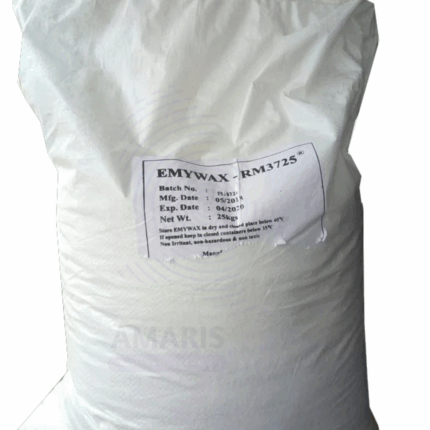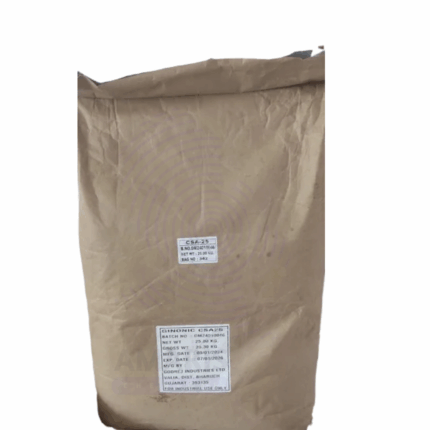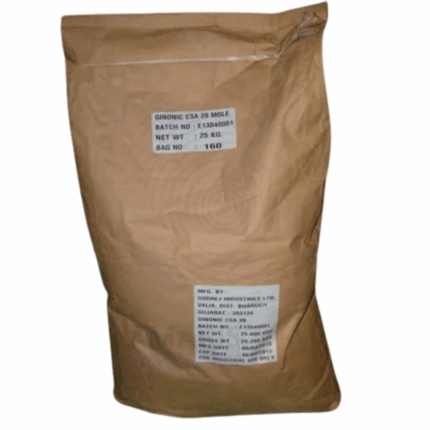Emulsifier NP-9
Whatsapp Order
Emulsifier NP-9 is a nonionic surfactant belonging to the family of Nonylphenol Ethoxylates (NPEs), specifically with an average of 9 ethylene oxide (EO) units. It is widely used as an effective emulsifying, wetting, dispersing, and solubilizing agent. NP-9 is typically a pale yellow to amber viscous liquid, soluble in water and various organic solvents. It is valued for its strong emulsifying ability to stabilize oil-in-water (O/W) and water-in-oil (W/O) emulsions, excellent detergency, and good compatibility with other surfactants and formulation ingredients. NP-9 is commonly employed in industrial, agricultural, cosmetic, pharmaceutical, and cleaning applications.
Description
Table of Contents
Toggle
Emulsifier ( Emulgator NP-9)
Primary Uses
- Industrial & Household Cleaning
- Used in detergents, degreasers, and all-purpose cleaners for its excellent emulsifying and wetting properties.
- Enhances soil removal by dispersing oily and particulate matter in aqueous cleaning solutions.
- Stabilizes formulations in heavy-duty liquid detergents and automatic dishwashing liquids.
- Agriculture
- Serves as an emulsifier and dispersant in pesticide and herbicide formulations to improve spray uniformity and active ingredient distribution.
- Enhances wetting and spreading properties on leaf surfaces, improving efficacy.
- Cosmetics & Personal Care
- Employed in creams, lotions, shampoos, and other personal care products to stabilize emulsions and improve texture and consistency.
- Improves the solubilization of hydrophobic ingredients, fragrances, and oils.
- Enhances product spreadability and sensory feel on the skin.
- Pharmaceuticals
- Used in topical creams, ointments, and gels as an emulsifier to ensure stable dispersion of active pharmaceutical ingredients.
- Facilitates controlled release and bioavailability by maintaining stable formulations.
- Paints, Coatings & Adhesives
- Acts as an emulsifier and dispersant to improve stability and texture in waterborne paints and coatings.
- Helps maintain uniform particle size distribution in latex and emulsion polymers.
Secondary Uses
- Textile Industry
- Used as a wetting and emulsifying agent during dyeing and finishing processes to improve dye uptake and uniformity.
- Rubber & Plastics
- Applied as a dispersant and emulsifier in polymerization and compounding processes.
- Metalworking Fluids
- Stabilizes emulsions in cutting oils and metalworking fluids to improve cooling and lubricating performance.
KEY PRODUCT FEATURES
1. Basic Identification Attributes
- Chemical Name (IUPAC): Nonylphenol, ethoxylated with ~9 EO units
- Common/Trade Name: Emulsifier NP-9, Emulgator NP-9
- CAS Number: 9016-45-9 (for nonylphenol ethoxylates generally)
- HS Code: 3402.19.00
- Molecular Formula: Variable (C15H24O + EO)n (depends on EO units)
- Synonyms:
- Nonylphenol Polyethoxylate (9 EO)
- NP-9
- Nonylphenol Ethoxylate 9
- Polyethylene glycol nonylphenyl ether
2. Physical & Chemical Properties
- Physical State: Pale yellow to amber viscous liquid
- Odor: Mild phenolic odor
- pH (1% aqueous solution): Typically 6–8 (neutral to slightly alkaline)
- Solubility: Soluble in water and various organic solvents (alcohols, glycols)
- Stability: Stable under normal storage; sensitive to strong acids and bases
- Cloud Point: Approx. 60–65°C (varies with concentration)
3. Safety & Hazard Attributes
- Hazard Class (GHS): Not classified as hazardous but may cause skin and eye irritation
- Toxicity: Moderate; avoid prolonged exposure
- Exposure Limits: Not specifically established
4. Storage & Handling Attributes
- Storage Conditions: Store in a cool, dry, well-ventilated place away from direct sunlight and oxidizers
- Container Type: Polyethylene drums or containers with tight seals
- Shelf Life: Typically 12–24 months if stored properly
- Handling Precautions: Avoid inhalation of vapors and skin/eye contact
5. Regulatory & Compliance Attributes
- Regulatory Status: Subject to environmental and safety regulations due to nonylphenol component (some restrictions in certain regions)
- REACH Registration: Registered but usage restrictions apply in EU for environmental concerns
- FDA Status: Not generally used in food products; cosmetic and industrial uses only
6. Environmental & Health Impact
- Biodegradability: Slowly biodegradable; concerns over persistence in aquatic environments
- Ecotoxicity: Toxic to aquatic organisms; use with caution to avoid environmental release
- Bioaccumulation: Potential for bioaccumulation due to nonylphenol content
- Carcinogenicity/Mutagenicity: Not classified as carcinogenic; some environmental toxicity concerns
SAFETY HANDLING PRECAUTIONS
Safety Handling Precautions
PPE Required:
- Chemical-resistant gloves
- Safety goggles or face shield
- Protective clothing (lab coat or apron)
- Adequate ventilation or respirator if vapors are present
Handling Guidelines:
- Use in well-ventilated areas to avoid inhalation of vapors
- Prevent skin and eye contact; wash thoroughly after handling
- Avoid spills and release into environment
Storage Measures:
- Keep containers tightly closed
- Store away from strong oxidizers and heat sources
- Protect from freezing and direct sunlight
Hygiene Practices:
- Wash hands and exposed skin after handling
- Do not eat, drink, or smoke while handling the chemical
- Clean equipment and surfaces regularly to prevent residue buildup
First Aid Measures
- Inhalation: Move affected person to fresh air; seek medical attention if symptoms develop
- Skin Contact: Wash with plenty of soap and water; remove contaminated clothing; seek medical advice if irritation persists
- Eye Contact: Rinse cautiously with water for several minutes; remove contact lenses if present; seek medical attention if irritation continues
- Ingestion: Rinse mouth; do not induce vomiting; seek immediate medical attention
Firefighting Measures
- Fire Hazards: Combustible liquid; can release toxic fumes when burned
- Extinguishing Media: Foam, dry chemical powder, carbon dioxide (CO₂), water spray
- Special Precautions: Wear self-contained breathing apparatus and protective gear
- Decomposition Products: May emit carbon monoxide, carbon dioxide, phenolic compounds, and other toxic gases upon combustion
Related products
Ceteareth 25 Ginonic
Ceteareth 25 Ginonic CSA 25 is a nonionic surfactant and emulsifier derived from the ethoxylation of cetearyl alcohol, incorporating approximately 20 ethylene oxide units per molecule. It appears as a white to off-white waxy solid or viscous liquid, depending on temperature and formulation. This emulsifier is widely used in cosmetic, pharmaceutical, and industrial formulations for its excellent ability to stabilize oil-in-water emulsions, improve texture, and enhance the sensory properties of finished products. Its high hydrophilic-lipophilic balance (HLB) makes it especially effective in forming stable emulsions and solubilizing lipophilic ingredients in aqueous phases. Ceteareth 20 is valued for its mildness, broad compatibility, and multifunctional performance.
Cetomacrogel 1000BP
Cetomacrogel 1000BP is a high molecular weight polyethylene glycol (PEG) derivative, typically used as a thickening agent, emulsifier, and stabilizer in pharmaceutical and cosmetic formulations. It appears as a white to off-white, waxy solid or flakes with a neutral odor. Known for its excellent water solubility and compatibility with various ingredients, Cetomacrogel 1000BP enhances texture, viscosity, and stability in creams, ointments, and gels. It serves as a hydrophilic vehicle base in topical and oral pharmaceutical preparations and improves product spreadability and skin feel.
Cocodiethanolamide (CDEA)
Cocodiethanolamide (CDEA) is a viscous, amber to dark brown liquid derived from the reaction of coconut oil fatty acids with diethanolamine. It is a non-ionic surfactant and foam stabilizer commonly used in personal care and cleaning products. CDEA enhances foam quality, viscosity, and skin conditioning properties in formulations. Due to its excellent emulsifying and thickening abilities, it is widely used as a secondary surfactant to boost the performance of primary detergents. It is valued for its biodegradability, mildness, and compatibility with various surfactants and other ingredients in cosmetics and industrial formulations.
Galsilk 700
Galsilk (Polyquartenum) is a water-soluble cationic polymer known chemically as Polyquaternium-7. It is widely used as a conditioning agent in personal care and cosmetic formulations, prized for its excellent substantivity to hair and skin, providing softness, smoothness, and antistatic effects. This polymer is typically supplied as a clear to slightly hazy viscous liquid or gel. It is compatible with a broad range of surfactants and ingredients, enhancing the sensory profile of shampoos, conditioners, styling products, and skincare formulations. Galsilk 700 is also valued for its film-forming properties and ability to improve product stability.
Mono Ethanol Amine
Mono Ethanol Amine (MEA) is a clear, colorless, hygroscopic liquid with an ammonia-like odor. It is an organic chemical compound combining both amine and alcohol functional groups. MEA is widely used as a versatile chemical intermediate and is especially important in gas treatment, detergents, and chemical manufacturing due to its alkalinity and solubility in water and organic solvents.
Stearic Acid Cosmetic Acid
Stearic Acid Cosmetic Grade is a high-purity, saturated fatty acid specially refined for use in cosmetic and personal care products. It is a waxy, white solid known for its excellent emulsifying, thickening, and stabilizing properties. This grade ensures minimal impurities and is compatible with a wide range of formulations including creams, lotions, soaps, and deodorants, providing smooth texture and enhanced product stability.
Turkey Red Oil (Sulphated Castor Oil)
Turkey Red Oil, also known as Sulphated Castor Oil, is a water-soluble derivative of castor oil produced through a sulfonation process using concentrated sulfuric acid. It results in a highly viscous, amber-colored liquid that acts as an excellent emulsifier, wetting agent, and dispersing agent. Unlike natural castor oil, it disperses easily in water, making it ideal for applications in textiles, cosmetics, agriculture, and industrial formulations. Its biodegradable and non-toxic nature also makes it eco-friendly and suitable for sensitive formulations.
Tween 20 (Polysorbate 20)
Tween 20, also known as Polysorbate 20, is a non-ionic surfactant and emulsifier derived from the esterification of sorbitan (from sorbitol) with fatty acids, followed by ethoxylation. It is a pale yellow to amber viscous liquid that is completely soluble in water, making it ideal for emulsifying oil-in-water systems. Tween 20 is widely used in cosmetics, pharmaceuticals, food, biotechnology, and industrial formulations due to its excellent emulsifying, dispersing, solubilizing, and stabilizing properties.


 Preservatives(food)
Preservatives(food) Flavor Enhancers
Flavor Enhancers Acidulants
Acidulants Sweeteners
Sweeteners Antioxidants
Antioxidants Colorants(food)
Colorants(food) Nutraceutical Ingredients (food)
Nutraceutical Ingredients (food) Nutrient Supplements
Nutrient Supplements Emulsifiers
Emulsifiers
 Collectors
Collectors Dust Suppressants
Dust Suppressants Explosives and Blasting Agents
Explosives and Blasting Agents Flocculants and Coagulants
Flocculants and Coagulants Frothers
Frothers Leaching Agents
Leaching Agents pH Modifiers
pH Modifiers Precious Metal Extraction Agents
Precious Metal Extraction Agents
 Antioxidants(plastic)
Antioxidants(plastic) Colorants (Pigments, Dyes)
Colorants (Pigments, Dyes) Fillers and Reinforcements
Fillers and Reinforcements Flame Retardants
Flame Retardants Monomers
Monomers Plasticizers
Plasticizers Polymerization Initiators
Polymerization Initiators Stabilizers (UV, Heat)
Stabilizers (UV, Heat)
 Antifoaming Agents
Antifoaming Agents Chelating Agents
Chelating Agents Coagulants and Flocculants
Coagulants and Flocculants Corrosion Inhibitors
Corrosion Inhibitors Disinfectants and Biocides
Disinfectants and Biocides Oxidizing Agents
Oxidizing Agents pH Adjusters
pH Adjusters Scale Inhibitors( water)
Scale Inhibitors( water)
 Antioxidants(cosmetic)
Antioxidants(cosmetic) Emollients
Emollients Fragrances and Essential Oils
Fragrances and Essential Oils Humectants
Humectants Preservatives
Preservatives Surfactants(cosmetic)
Surfactants(cosmetic) Thickeners
Thickeners UV Filters
UV Filters
 Fertilizers
Fertilizers Soil Conditioners
Soil Conditioners Plant Growth Regulators
Plant Growth Regulators Animal Feed Additives
Animal Feed Additives Biostimulants
Biostimulants Pesticides (Herbicides, Insecticides, Fungicides)
Pesticides (Herbicides, Insecticides, Fungicides)
 Active Pharmaceutical Ingredients (APIs)
Active Pharmaceutical Ingredients (APIs) Excipients
Excipients Solvents(pharmaceutical)
Solvents(pharmaceutical) Antibiotics
Antibiotics Antiseptics and Disinfectants
Antiseptics and Disinfectants Vaccine Adjuvants
Vaccine Adjuvants Nutraceutical Ingredients (pharmaceutical)
Nutraceutical Ingredients (pharmaceutical) Analgesics & Antipyretics
Analgesics & Antipyretics
 Analytical Reagents
Analytical Reagents Solvents(lab)
Solvents(lab) Chromatography Chemicals
Chromatography Chemicals Spectroscopy Reagents
Spectroscopy Reagents microbiology-and-cell-culture-reagents
microbiology-and-cell-culture-reagents Molecular Biology Reagents
Molecular Biology Reagents Biochemical Reagents
Biochemical Reagents Inorganic and Organic Standards
Inorganic and Organic Standards Laboratory Safety Chemicals
Laboratory Safety Chemicals Specialty Laboratory Chemicals(Special Laboratory Equipment)
Specialty Laboratory Chemicals(Special Laboratory Equipment)
 Demulsifiers
Demulsifiers Hydraulic Fracturing Fluids
Hydraulic Fracturing Fluids Scale Inhibitors(oil)
Scale Inhibitors(oil) Surfactants(oil)
Surfactants(oil) Drilling Fluids
Drilling Fluids
 Dyes and Pigments
Dyes and Pigments Bleaching Agents
Bleaching Agents Softening Agents
Softening Agents Finishing Agents
Finishing Agents Antistatic Agents
Antistatic Agents
 Admixtures
Admixtures Waterproofing Agents
Waterproofing Agents Sealants and Adhesives
Sealants and Adhesives Curing Compounds
Curing Compounds Concrete Repair Chemicals
Concrete Repair Chemicals Anti-Corrosion Coatings
Anti-Corrosion Coatings
 Surfactants(cleaning)
Surfactants(cleaning) Builders
Builders Enzymes
Enzymes Solvents (Cleaning)
Solvents (Cleaning) Fragrances
Fragrances
 Electronic Chemicals
Electronic Chemicals Catalysts
Catalysts Lubricants
Lubricants Photographic Chemicals
Photographic Chemicals Refrigerants
Refrigerants Automotive chemicals
Automotive chemicals Pyrotechnic Chemicals
Pyrotechnic Chemicals
 Biodegradable Surfactants
Biodegradable Surfactants Bio-based Solvents
Bio-based Solvents Renewable Polymers
Renewable Polymers Carbon Capture Chemicals
Carbon Capture Chemicals Wastewater Treatment Chemicals
Wastewater Treatment Chemicals
 Pigments
Pigments Solvents(paint)
Solvents(paint) Specialty Coatings
Specialty Coatings Binders/Resins
Binders/Resins Additives
Additives Driers
Driers Anti-Corrosion Agents
Anti-Corrosion Agents Functional Coatings
Functional Coatings Application-Specific Coatings
Application-Specific Coatings
 Fresh Herbs
Fresh Herbs Ground Spices
Ground Spices Whole Spices
Whole Spices Spice Blends
Spice Blends Dried Herbs
Dried Herbs
 Leavening Agents
Leavening Agents Dough Conditioners
Dough Conditioners Flour Treatments
Flour Treatments Fat Replacers
Fat Replacers Decoratives
Decoratives Preservatives(baking)
Preservatives(baking)
 Plasticizers & Softeners
Plasticizers & Softeners Reinforcing Agents
Reinforcing Agents Adhesion Promoters
Adhesion Promoters Vulcanizing Agents
Vulcanizing Agents Antidegradants
Antidegradants Blowing Agents
Blowing Agents Fillers & Extenders
Fillers & Extenders Accelerators & Retarders
Accelerators & Retarders





















